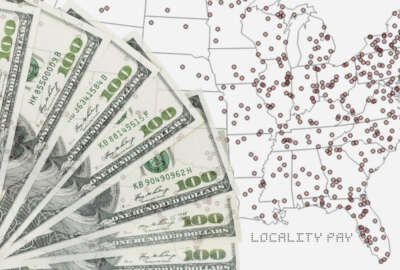Pay agent renews calls for ‘major legislative reforms’ to federal pay
The pay agent also announced upcoming plans to add two counties to the Seattle-Tacoma, Washington, locality pay area.
The Biden administration is once again calling for “major legislative reforms” to a federal pay system that many experts say has been broken for decades.
The General Schedule, the system that pays roughly 1.5 million civilian federal employees, is in need of an overhaul, the President’s Pay Agent said in its annual report, published Tuesday.
Specifically, the three-person pay agent, composed of Office of Personnel Management Director Kiran Ahuja, acting Labor Secretary Julie Su and Office of Management and Budget Director Shalanda Young, said the GS system’s use of locality pay doesn’t account for different occupations, for which salaries can widely vary.
“The current pay comparison methodology used in the locality pay program ignores the fact that non-federal pay in a local labor market varies substantially between different occupational groups,” the pay agent said in its October 2023 report. “As currently applied, locality payments in a local labor market may leave some mission-critical occupations significantly underpaid while overpaying others.”
The conversation around federal pay reform is far from new. The Biden administration has made nearly identical and repeated calls for a restructure to the pay system since its first pay agent report in 2021. But it’ll take action from Congress to address the long-standing issue, according to the pay agent.
Previous pay agents, including those from both the Obama and Trump administrations, have similarly suggested the government should consider “reforms to the white-collar federal pay system,” a 2015 report from the pay agent said. The Trump administration advocated for a revision to the GS system in 2020.
“As has been noted in earlier pay agent reports and discussed in other venues, we believe there is a need to consider major legislative reforms of the GS pay system,” the pay agent said in the October 2023 report.
In 2022, federal workers earned about 24% less in wages alone than their non-federal colleagues — a gap that grew since the last calculation of 22.5% in 2021, according to the Federal Salary Council. The council measures these disparities by comparing base pay rates of GS employees with the wages for their non-federal colleagues in similar roles and experience levels and who work in the same geographic region.
Some experts disagree that federal pay falls behind that of the private sector. When accounting for the value of benefits, and not just wages alone, some economists and groups such as the Congressional Budget Office said that federal employees are actually overpaid.
But similar to the pay agent, many federal advocacy groups and unions have called for significant changes to, or even a full replacement of, the GS system.
Challenges with the GS system can additionally complicate agency recruitment and retention. Many federal chief human capital officers (CHCOs) said that the GS pay system is the “single greatest obstacle” for agencies when competing with the private sector for new talent and retaining high-performing employees. It’s a particularly acute challenge for hard-to-fill positions, such as those in IT and cybersecurity.
Earlier this year, the Biden administration hinted at recommending a legislative fix to pay compression, an effort that would address at least part of the challenge of the GS system. Pay compression is a phenomenon that curbs salaries for some senior-level GS employees due to legal pay caps.
So far, there has not been an actual proposal from the Biden administration, and it remains unclear when or if a proposal will come forward.
A “substantial impact” on agency budgets
At the same time that the government faces these pay challenges, the cost of addressing the wage disparity is also growing rapidly.
The pay agent’s latest report estimated that it would cost $22 billion to bring GS federal salaries in line with the private sector. In its 2022 report, that estimate was $19.2 billion.
The previous two pay agent reports from the Biden administration said the cost is a “significant consideration.”
But this year’s report took a more direct stance and said the cost would “have a substantial impact on agency budgets.”
Many of these challenges go back decades. In 1990, Congress passed the Federal Employee Pay Comparability Act (FEPCA). The law was originally designed to eliminate what federal economists observed to be a growing pay gap between non-federal and civil service salaries.
FEPCA authorized the government to reduce the public-private wage gap to 5%. But since 1994, no president has fully implemented FEPCA and instead has opted for “alternative pay plans.”
In August, President Joe Biden followed this same path as his predecessors and announced an alternative pay plan for a 5.2% pay raise in 2024. The pay raise will not become official until Biden signs off on an executive order at the end of the year, and there is still time for Congress to potentially offer up an alternative raise.
Over time, the continued use of alternative pay plans has led many federal pay experts to question whether FEPCA and the methodology used to set locality pay ever truly made sense.
“The underlying methodology for locality pay of relying on one singular locality rate covering a locality pay area has lacked credibility since the beginning of locality pay in 1994 to such a degree that the statutory formula for closing pay gaps has been overridden either by Congress or by successive presidents every year since that first year,” the pay agent said in its 2023 report.
A few tweaks to Seattle’s locality pay area
Within the current bounds of the GS pay system, the pay agent announced upcoming plans to expand one existing locality pay area.
Jefferson and Clallam counties will soon be added to the Seattle-Tacoma, Washington, locality pay area, according to the pay agent.
The pay agent typically extends existing locality pay areas in instances where any county in the “Rest of U.S.” locality pay area is surrounded entirely by other counties in another higher locality pay area. In this instance, the pay agent determined that applies to the two counties outside Seattle.
OPM must still approve the change through the rulemaking process. It’s unclear when exactly the change will take effect, but it could happen as soon as 2024, depending on how long that process takes.
The planned expansion follows after the addition of four new localities for 2024. In June, OPM published proposed regulations to establish four new locality pay areas:
- Fresno-Madera-Hanford, California
- Reno-Fernley, Nevada
- Rochester-Batavia-Seneca Falls, New York
- Spokane-Spokane Valley-Coeur d’Alene, Washington-Idaho
The additional locality pay areas will likely yield slightly bigger raises for close to 33,000 federal civilian employees. OPM plans to implement the changes in time for the planned 2024 pay raise in January.
Copyright © 2024 Federal News Network. All rights reserved. This website is not intended for users located within the European Economic Area.
Drew Friedman is a workforce, pay and benefits reporter for Federal News Network.
Follow @dfriedmanWFED






